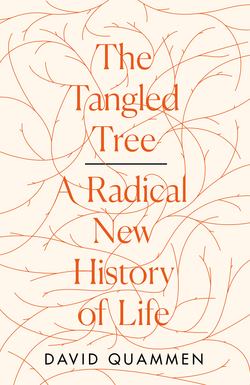Читать книгу The Tangled Tree: A Radical New History of Life - David Quammen, David Quammen - Страница 15
8
ОглавлениеDarwin explored the tree simile in one extended paragraph, ending that chapter of The Origin. “The green and budding twigs may represent existing species,” he wrote. From there he worked backward: woody twigs and small branches as recently extinct forms; competition between branches for space and for light; big limbs dividing into branches, then those into lesser branches; all ascending and spreading from a single great trunk. “As buds give rise by growth to fresh buds,” Darwin wrote, and those buds grow to be twigs, and those twigs grow to be branches, some vigorous, some feeble, some thriving, some dying, “so by generation I believe it has been with the great Tree of Life, which fills with its dead and broken branches the crust of the earth, and covers the surface with its ever branching and beautiful ramifications.” There’s a nice word: ramifications.
It’s especially good in this context because, while the literal definition is “a structure formed of branches,” from the Latin ramus, of course the looser definition is “implications.” Darwin’s tree certainly had implications.
Furthermore his book, like Edward Hitchcock’s, included a treelike illustration. This was the only illustration, the only graphic image of any sort, in the first edition of The Origin. It appeared between pages 116 and 117, amid his discussion of how lineages diverge over time. A foldout, again like Hitchcock’s, but published in simple black and white. It was a schematic figure, not an artfully drawn tree, not even so lively as the little sketch in his notebook long ago. Darwin called it a diagram. It showed hypothetical lineages, proceeding upward through evolutionary time and diverging—that is, dotted lines, rising vertically and branching laterally. Darwin was no artist, but, even lacking such talent, he could have laid out this diagram with a pencil and a ruler. In its draft version, as sent to the lithographer, he probably had. But it made the arboreal point.
Each increment of vertical distance on the ruled page, Darwin explained, stood for a thousand generations of inheritance. Deep time. Eleven major lineages began the ascent. Eight of those came to dead ends—meaning, they went extinct. Trilobites, ammonites, ichthyosaurs, and plesiosaurs had all suffered such ends, leaving no descendants of any sort. One lineage rose through the eons without splitting, without tilting, like a beanstalk—meaning that it persisted through time, unchanged. That’s much the way horseshoe crabs, sometimes called living fossils, have survived relatively unchanged (at least externally, so far as fossilization can show) over 450 million years. The other two lineages, dominating the diagram, branched often and spread horizontally—as well as climbed vertically. Their branching and horizontal spread represented the exploration of different niches by newly evolved forms. So there it all was: evolution and the origins of diversity.
Darwin’s diagram of divergence, from On the Origin of Species, 1859.
Back in Massachusetts, Edward Hitchcock read Darwin’s book, and it stuck in his craw. This wasn’t his first exposure to the idea of transmutation (he knew of Lamarck’s work and some other wild speculations), but it was the latest statement of that idea, the most concrete and logical, and therefore the most dangerously persuasive. Like some other pious scientists who chose to see God’s hand acting directly in the fossil record—Louis Agassiz at Harvard, François Jules Pictet in Geneva, and Adam Sedgwick, who had been Darwin’s mentor in geology at Cambridge—Hitchcock wasn’t pleased.
Into the 1860 edition of his Elementary Geology, he inserted his rejoinder to Darwin’s book, based mainly on proof by authority. He noted that Pictet saw no evidence for transmutation in the fossil record of fishes. Agassiz said that the resemblances among animals derive from—where?—the mind of the Creator. “It is well to take heed to the opinions of such masters in science,” Hitchcock wrote, “when so many, with Darwin at their head, are inclined to adopt the doctrine of gradual transmutation in species.”
That was mild but firm, a dismissive shrug. Hitchcock would ignore Charles Darwin and encourage his readers to do likewise. More telling, more defensive, was his other response: he removed the trees figure from his own book. No more Paleontological Chart. It seems never to have appeared in another edition of Elementary Geology.
Darwin and Darwin’s followers owned the tree image now. It would remain the best graphic representation of life’s history, evolution through time, the origins of diversity and adaptation, until the late twentieth century. And then rather suddenly a small group of scientists would discover: oops, no, it’s wrong.
